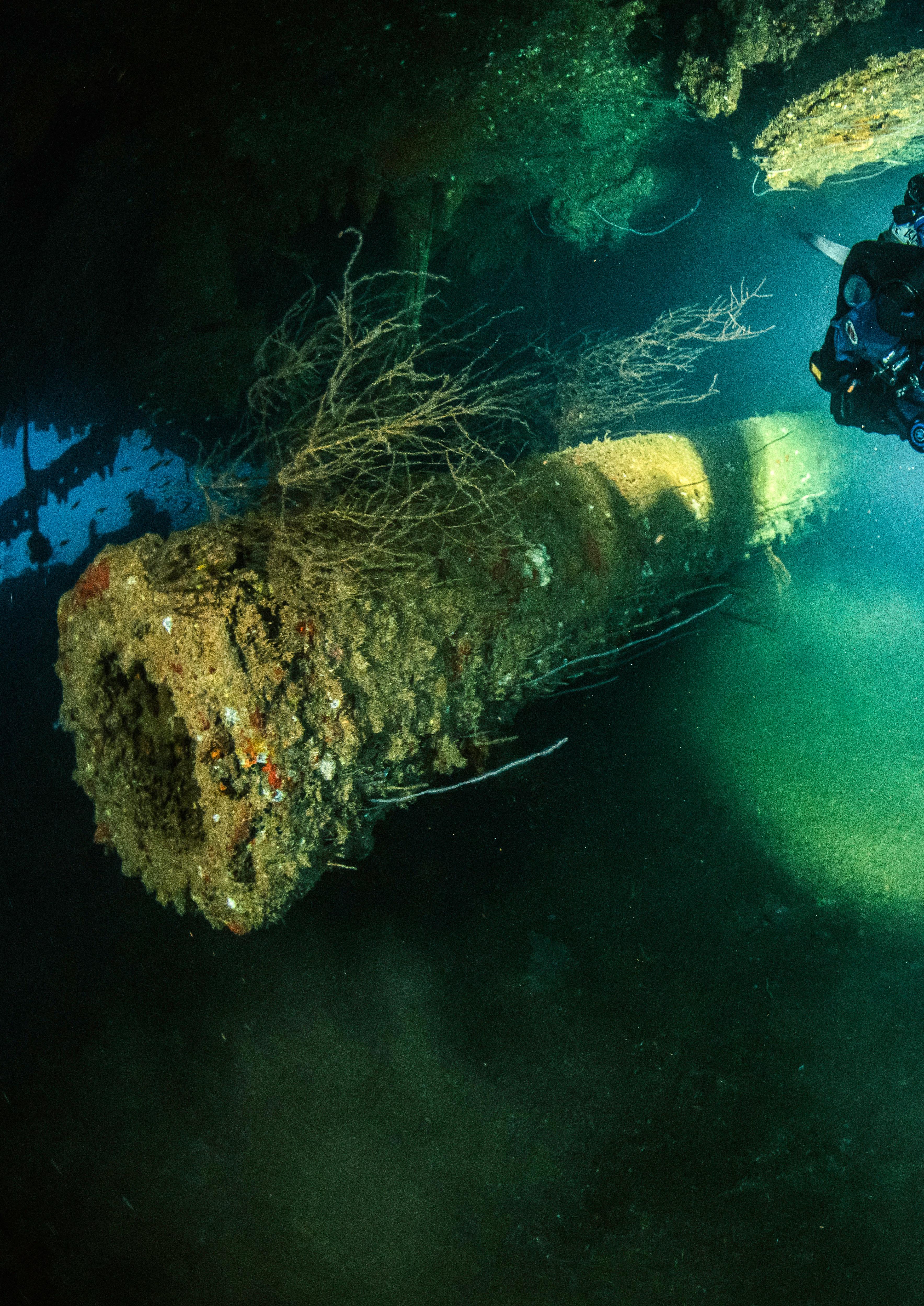
15 minute read
The 20 Best Wrecks in the World from Atlanta to Zenobia
FEATURE AND PHOTOGRAPHY JESPER KJØLLER
What creates a great wreck? Obviously, personal preferences will make some divers choose differently, but my subjective hit list is based on factors such as historic importance, an interesting narrative surrounding the loss at sea, and maybe a certain X-factor that is hard to quantify. Some of the most exciting wrecks have more than one story to tell. If the wreck both has an interesting history surrounding the initial loss and an equally compelling tale concerning the later discovery, it scores higher on my list. It also matters that the wreck is photogenic, has a certain size and is in good shape for its age. Interesting artefacts still on board, level of intactness, and the marine life are also factors considered. I have dived more than a dozen of the wrecks on this top twenty list already, and the rest is on my bucket list.
1. SS ANDREA DORIA
TYPE Ocean Liner
AREA Nantucket Island, North Atlantic
DEPTH 82 metres
LOST 25 July 1956
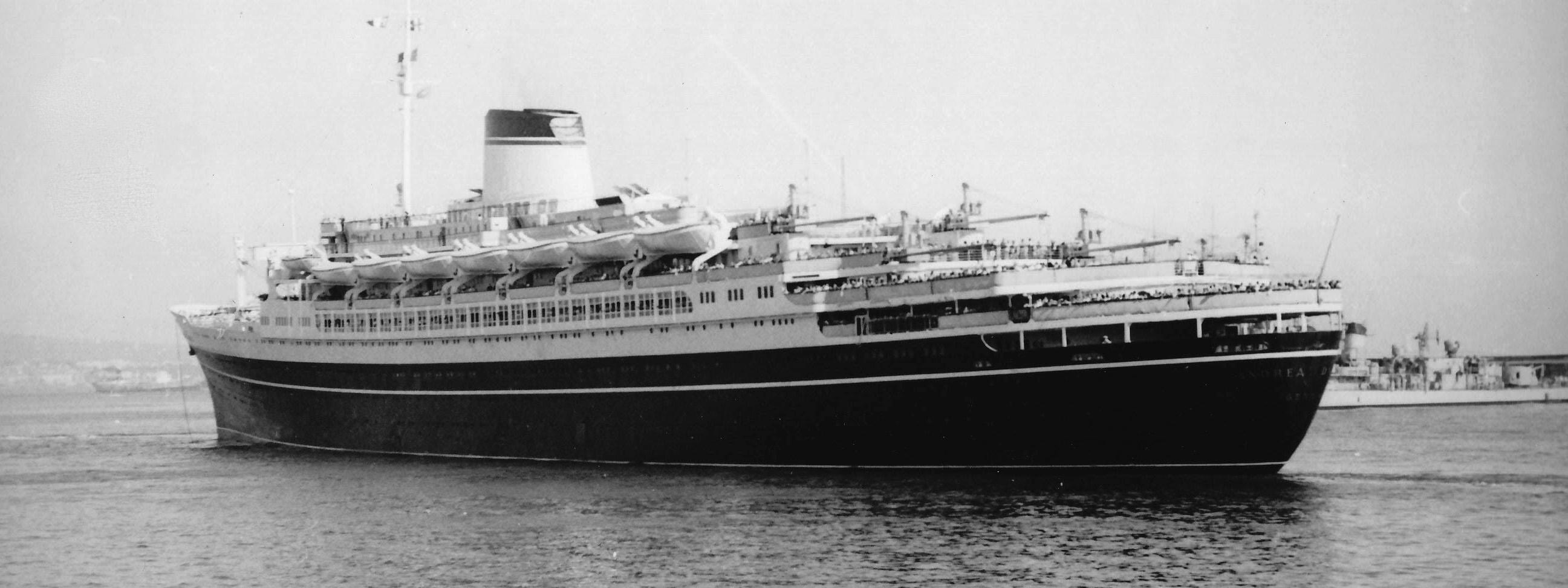
1. SS Andrea Doria in the North Atlantic, sunk in 1956.
A Luxurious ocean liner and an icon of national pride as the largest, fastest and allegedly safest of all Italian ships of the time. While heading for New York, she collided with MS Stockholm in one of history’s most infamous maritime disasters. The top-heavy Andrea Doria started to list severely, which left half of the lifeboats unusable. But she stayed afloat for 11 hours and “only” 46 people lost their lives.
Andrea Doria’s depth was a huge challenge for the first generation of advanced divers. The coveted branded porcelain lured many divers deep into the wreck and the “china fever” claimed numerous lives. Today, she is fast decaying and is believed to be empty of artefacts. However, since she played an important role in the development of deep wreck diving techniques such as the use of helium, accelerated decompression and advanced penetration procedures, she stills belongs on the top 20 list.
2. USS ATLANTA
TYPE Light Cruiser
AREA Guadalcanal, Solomon Islands
DEPTH 130 metres
LOST 13 November 1942

2. USS Atlanta in the Solomon Islands, sunk in 1942.
In her short life, she played a pivotal role in the Pacific War theatre escorting famous aircraft carriers such as the USS Enterprise and USS Hornet back and forth between Pearl Harbor and Midway before moving onto the Solomon Islands. She was hit by friendly fire during the battle of Guadalcanal and ended up sinking three miles west of Lunga Point.
The wreck was located in 1992 by a team led by Robert Ballard (who also found the Titanic and Bismarck), but because of strong surface currents and the remote location in the Solomons, with very poor infrastructure, the wreck has only been dived a few times and very sporadically. Last successful expedition was carried out by a team of leading GUE-divers.
3. BIANCA C
TYPE Passenger Ship
AREA Granada
DEPTH 50 metres
LOST 22 October 1961

3. Bianca C found in Granada, sunk in 1961.
Not many ships can brag about being wrecked twice, but Bianca C can. Construction began in France under WWII but the unfinished hull was scuttled by German troops. After the war, the 180-metre-long structure was salvaged and completed. In 1961, while anchored in Grenada, an explosion shook the engine room. The burning ship could potentially block the harbour, so an attempt to tow Bianca C was made. Thousands of Grenadians watched from the mountains as the tow progressed for six hours, but the Bianca C had only moved 5 km when the towline broke. Bianca C sank – again. Today she is the largest wreck in the Caribbean and it takes several dives to explore the site.
4. HMHS BRITANNIC
TYPE Ocean Liner
AREA Kea Channel, Greece
DEPTH 120 metres
LOST 21 November 1916
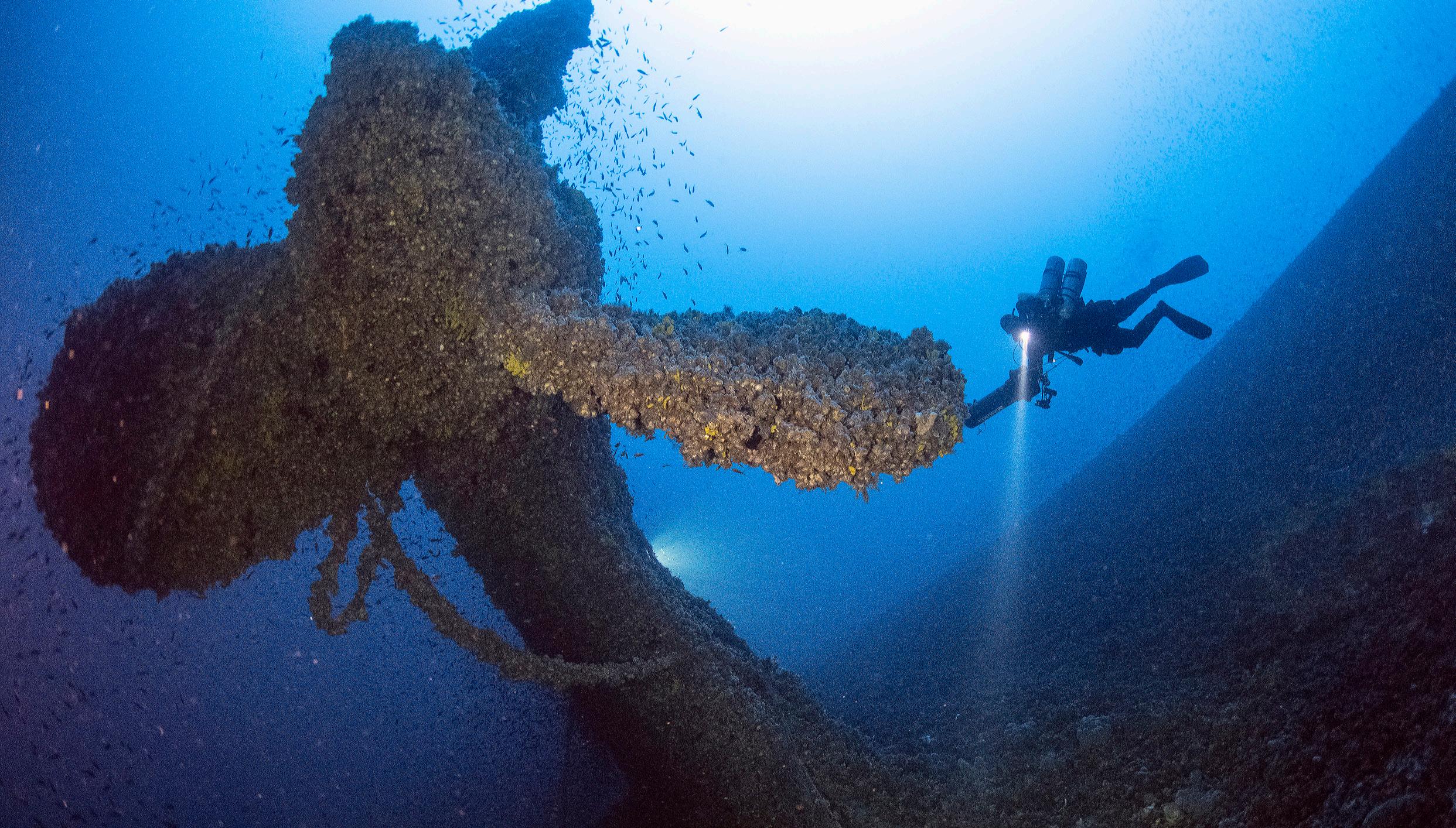
4. HMHS Britannic.
If the Titanic did not rest at 3,800 metres, she would probably be the star of any wreck divers wish list. Fortunately, her sister ship is within diveable depths, but only for the most experienced tech divers at 120 metres in the busy Kea Channel outside Athens. It’s a challenging dive by any measure.
As her ill-fated sister, Britannic was supposed to enter service as a transatlantic passenger liner and was improved in a number of ways due to lessons learned from the sinking of the Titanic. She never went into service but was operating as a hospital ship during WWI when she hit a mine and foundered in less than an hour.
Britannic has it all: A marvellous pedigree, a mystery concerning the sinking, an exciting narrative surrounding Cousteau’s discovery, early trimix dives on the wreck in 1975, and a number of high-profile expeditions from 1999 and onwards.
5. HILMA HOOKER
TYPE Freighter
AREA Bonaire
DEPTH 30 metres
LOST 12 September 1984

5. Hilma Hooker.
The only wreck on the list that can be reached from shore. The ship was under surveillance by drug enforcement agencies and local authorities inspected her while docked at Town Pier in Bonaire. They discovered and confiscated 11 tons of marijuana. The owner was never found and the ship was left to rot away. One morning she began to take in water, but before sinking in the harbour she was towed away and ended on a sandy area between two coral reefs. It is unclear if Hilma Hooker was put there on purpose by the local dive centre community, but the location is perfect for divers and she is among the best shore diving wrecks in the world.
6. S/S HINDENBURG
TYPE Icebreaker
AREA Åland Islands, Bothnian Sea
DEPTH 50 metres
LOST 9 March 1918

6. S/S Hindenburg
Not to be confused with SMS Hindenburg in Scapa Flow or the ill-fated blimp of the same name, the S/S Hindenburg was a German icebreaker. During WWI she was part of Transportflotte I of the Sonderverband Ostsee when she hit a mine frozen in the ice. Three men were killed in the explosion. What makes this dive special is the fact that all wrecks in the autonomous Finish province Åland is protected by law and you will see artefacts here that would be long gone almost anywhere else. Hindenburg is extremely well preserved in the cold and fresh water in the Bothnian Sea and you can enjoy many details like telegraphs, compass housings, and a complete galley on Hindenburg.
7. SMS KRONPRINZ (WILHELM)
TYPE Battleship
AREA Scapa Flow
DEPTH 43 metres
LOST 21 June 1919

7. SMS Kronprinz Wilhelm in the Scapa Flow, lost in 21 June 1919.
The König class battleship SMS Kronprinz was laid down in Kiel in 1911. She participated in the Battle of Jutland, the largest naval battle of World War I, but she remained unharmed and suffered no loss of life. In 1918 she was renamed Kronprinz Wilhelm. And the following year she was part of the interned fleet in Scapa Flow and was eventually scuttled by admiral Ludwig von Reuter. The immense size of the wreck can be intimidating and you need several dives to come away with a greater appreciation for her many details. Many of the 12-inch guns are accessible and visible.
8. HIJMS NAGATO
TYPE Battleship
AREA Bikini Atoll
DEPTH 54 metres
LOST July 1946
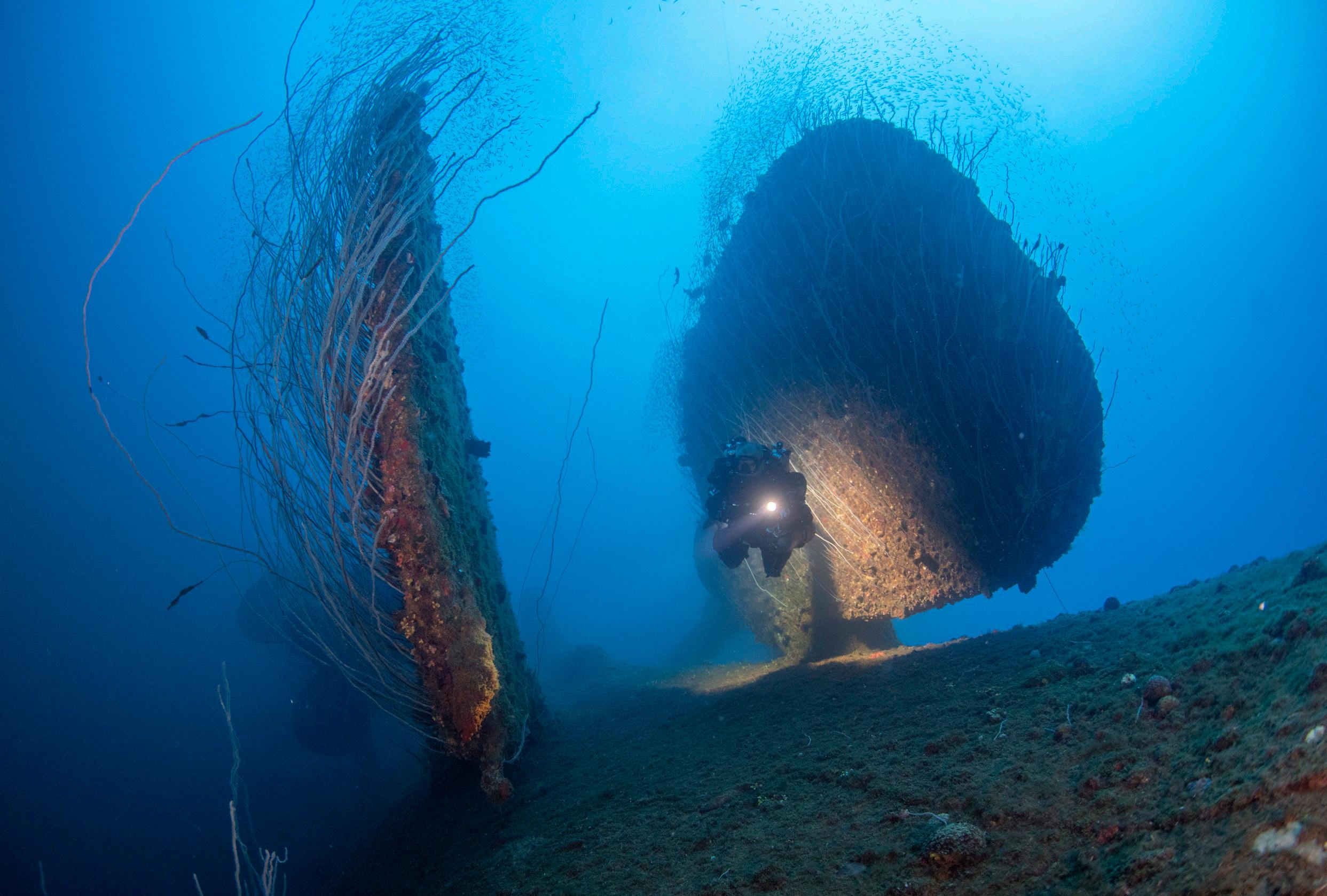
8. HIJMS Nagato in Bikini Atoll, lost in July 1946.
Admiral Yamamoto directed the attack on Pearl Harbor on December 7, 1941 from the bridge of the Nagato. The battleship with the pagoda style superstructure was later impounded by the Americans and included in the Operation Crossroads in Bikini to gather information on enemy shipbuilding techniques after an atomic explosion.
Nagato’s biggest highlights are the four enormous propellers and the twin 16.1-inch guns which were the biggest in the world at the time. Even though the superstructure is partly squashed under the weight of the overturned hull, it is possible to squeeze into the bridge and pretend to be Admiral Yamamoto listening to the famous radio code word Tora! Tora! Tora! – the signal to commence the attack on Pearl Harbor.
9. MARS THE MAGNIFICENT
TYPE Battleship
AREA Swedish East Coast, Baltic Sea
DEPTH 72 metres
LOST May 1564
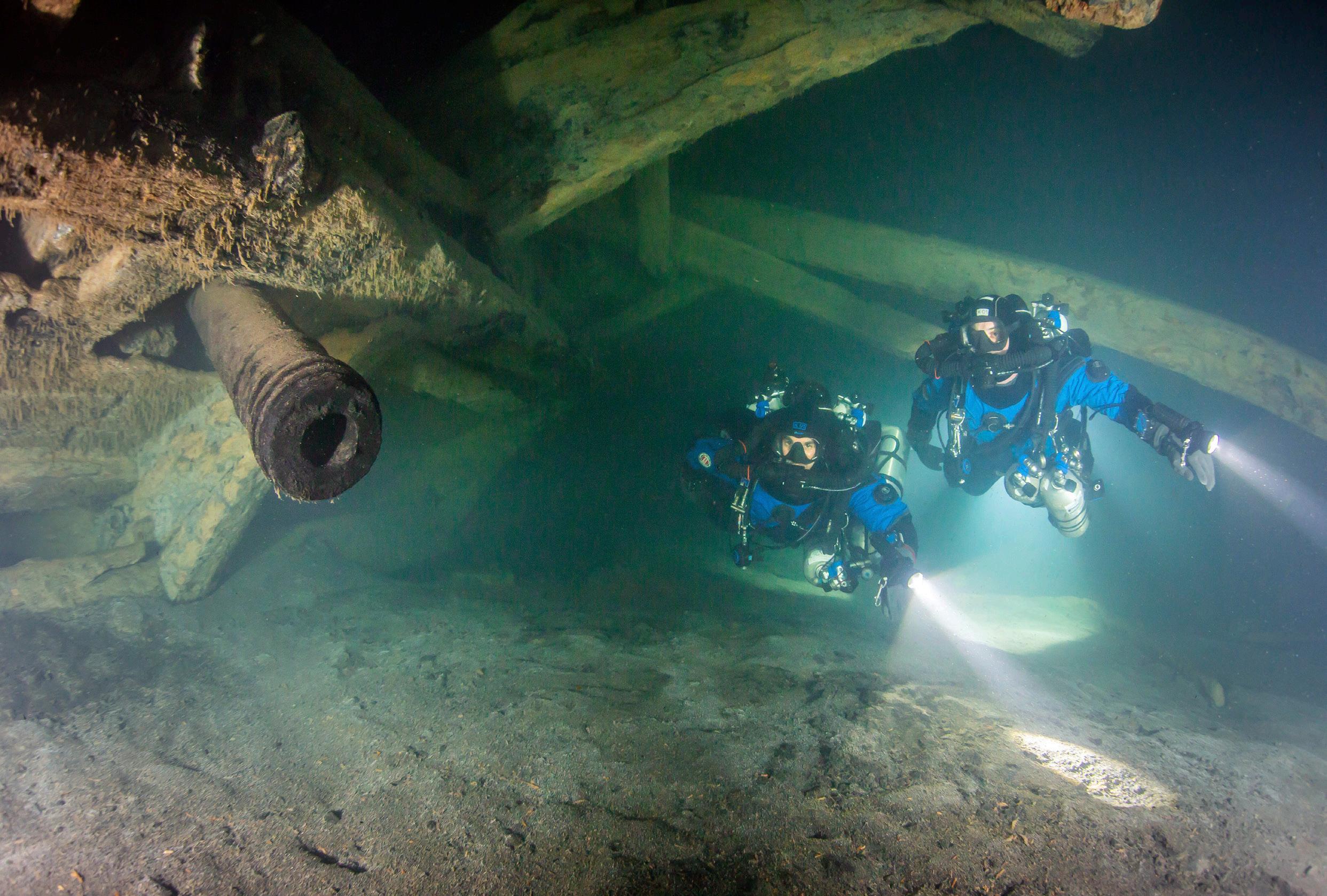
9. Mars the Magnificent in the Swedish East Coast, Baltic Sea, lost May 1564.
Photo by Kees Beemster Leveretz
The oldest ship on the list, and possibly the most significant wreck discovery of the century.
Mars was located by Richard Lundgren and his team in 2011 after searching more than 20 years for it. This Swedish battleship was the largest of its time, but Mars was defeated by a fleet of Danish soldiers and German mercenaries, and when the powder stores on board caught fire, Mars exploded, and 800 soldiers perished.
Ongoing scientific research projects on Mars are breaking new ground in digital excavation. The photogrammetry models based on data collected by divers, are setting new standards in non-destructive archaeology.
10. USS ORISKANY
TYPE Aircraft Carrier
AREA Mexican Gulf
DEPTH 64 metres, flight deck 41 metres
SCUTTLED 17 May 2006
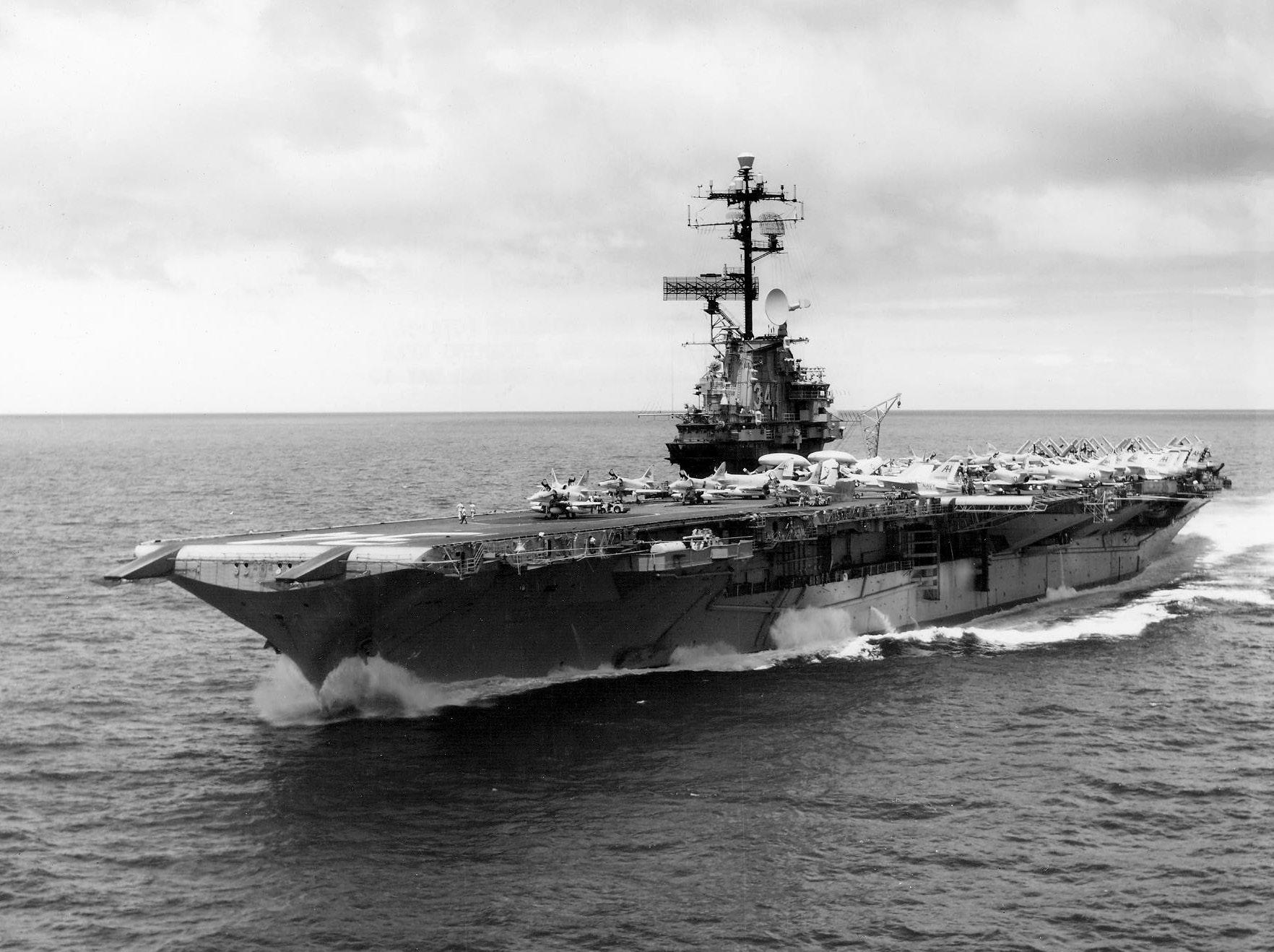
10. USS Oriskany near Midway Atoll in 1967. Scuttled in the Mexican Gulf in 2006.
The only wreck on the list scuttled on purpose, which among some purists, disqualifies the Oriskany from being a “real” wreck, but the sheer size of this mighty one – for me – is enough to warrant a nomination. And she is one of the very few aircraft carrier wrecks in the world. USS Oriskany was completed right after WWII and operated in the Pacific well into the 1970s. She served during the Korean War and later the Vietnam War. After being decommissioned in 1976, she lay idle for almost 30 years until it was decided to scuttle her outside Pensacola in Florida. It took a lot of work to clean the enormous vessel and make her environmentally ready for disposal on the seabed. She remains the biggest artificial reef in the world.
11. PRESIDENT COOLIDGE
TYPE Ocean Liner
AREA Vanuatu, Pacific Ocean
DEPTH Bow 21 metres, stern 73 metres
LOST 26 October 1942
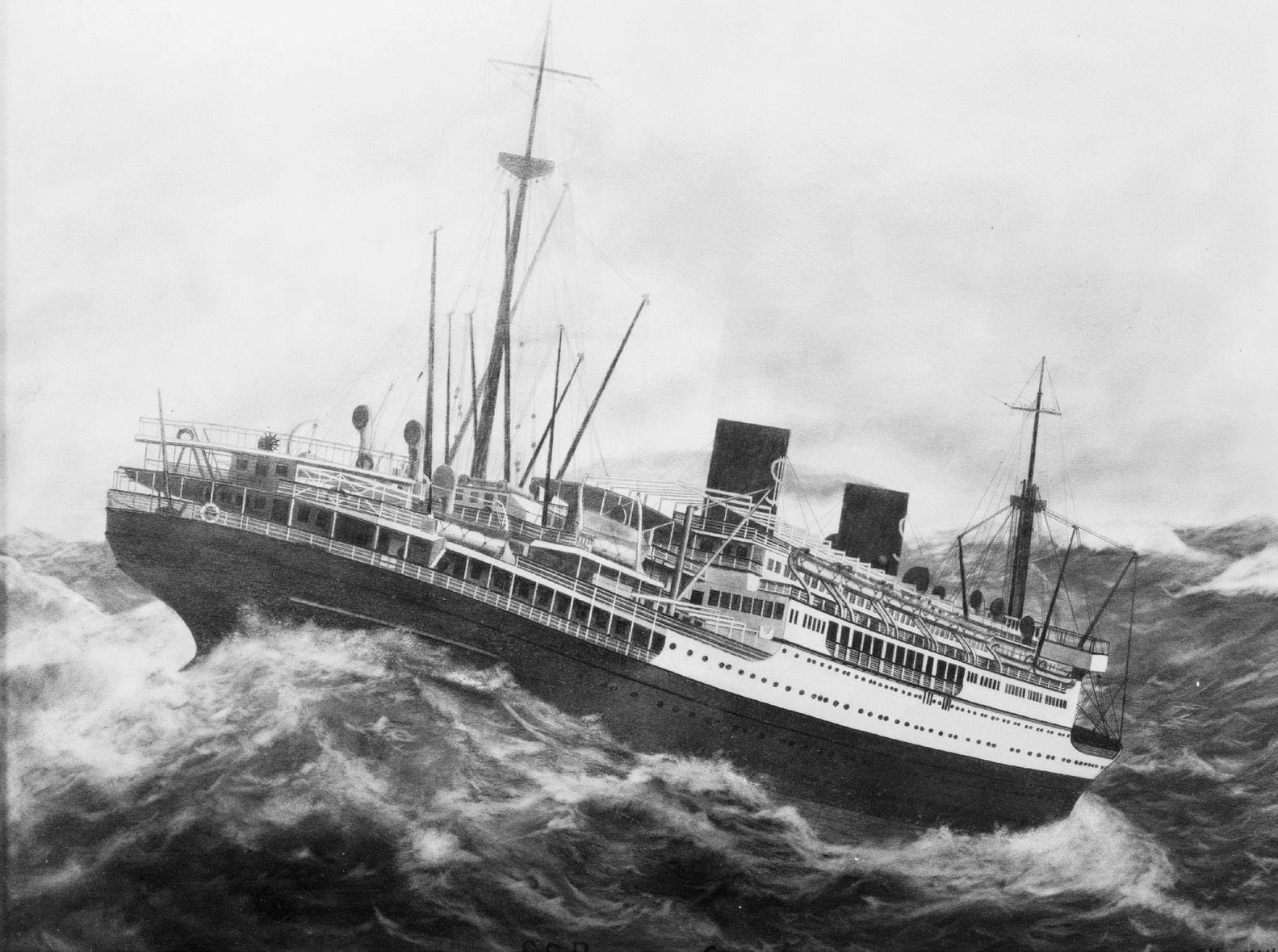
11. President Coolidge (1931) by Newman. Lost in October 1942 in Vanuatu, Pacific Ocean.
Built as an American luxury ocean liner in 1931, she served as a troopship during the beginning of WWII. She sank after hitting two mines in the New Hebrides (today part of Vanautu).
The captain realised the ship was lost, so he ran her aground and ordered the 5,340 troops to disembark without their belongings as he thought they would be able to retrieve them later, but shortly after, the enormous wreck slid down the sloping coral reef.
President Coolidge is probably the most accessible large ocean liner wreck and you need several dives to explore the almost 200-metre long ship. Beware though, as it is very easy to exceed dive limits due to the gradual downward slope.
12. PRINZ EUGEN
TYPE Heavy Cruiser AREA Kwajalein Atoll DEPTH 34 metres LOST 22 December 1946
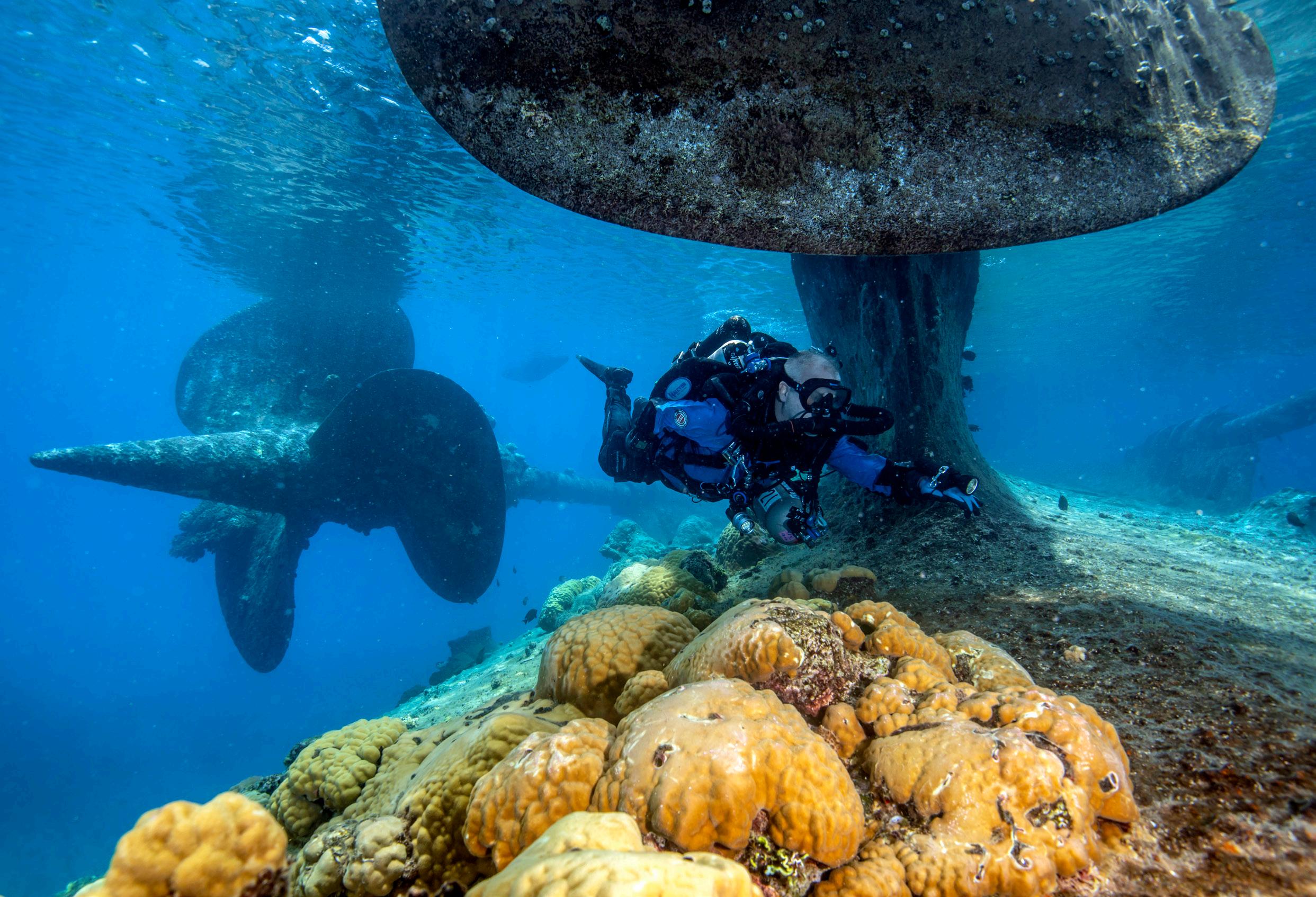
12. Prinz Eugen in Kwajalein Atoll, lost in December 1946.
The German heavy cruiser was launched in 1938. She saw lots of action in famous battles during WWII, primarily in the North Sea war theatre. After the collapse of the Axis Powers in 1945, she ended up with the US Navy as a war prize. It was decided to include her in Operation Crossroads to evaluate the effect of a nuclear bomb on a German built battleship. Prinz Eugen survived both atomic blasts and was later towed to Kwajalein Atoll 400 miles away. She started to take in water but the leak could not be fixed due to the radiation. She capsized and sank in shallow water. Today the enormous wreck can easily be dived as the propeller sticks out of the water.
13. SS NUMIDIA
TYPE Steam Cargo Ship AREA Brothers Islands, Northern Red Sea DEPTH Stern 80 metres, bow 10 metres LOST 6 July 1901
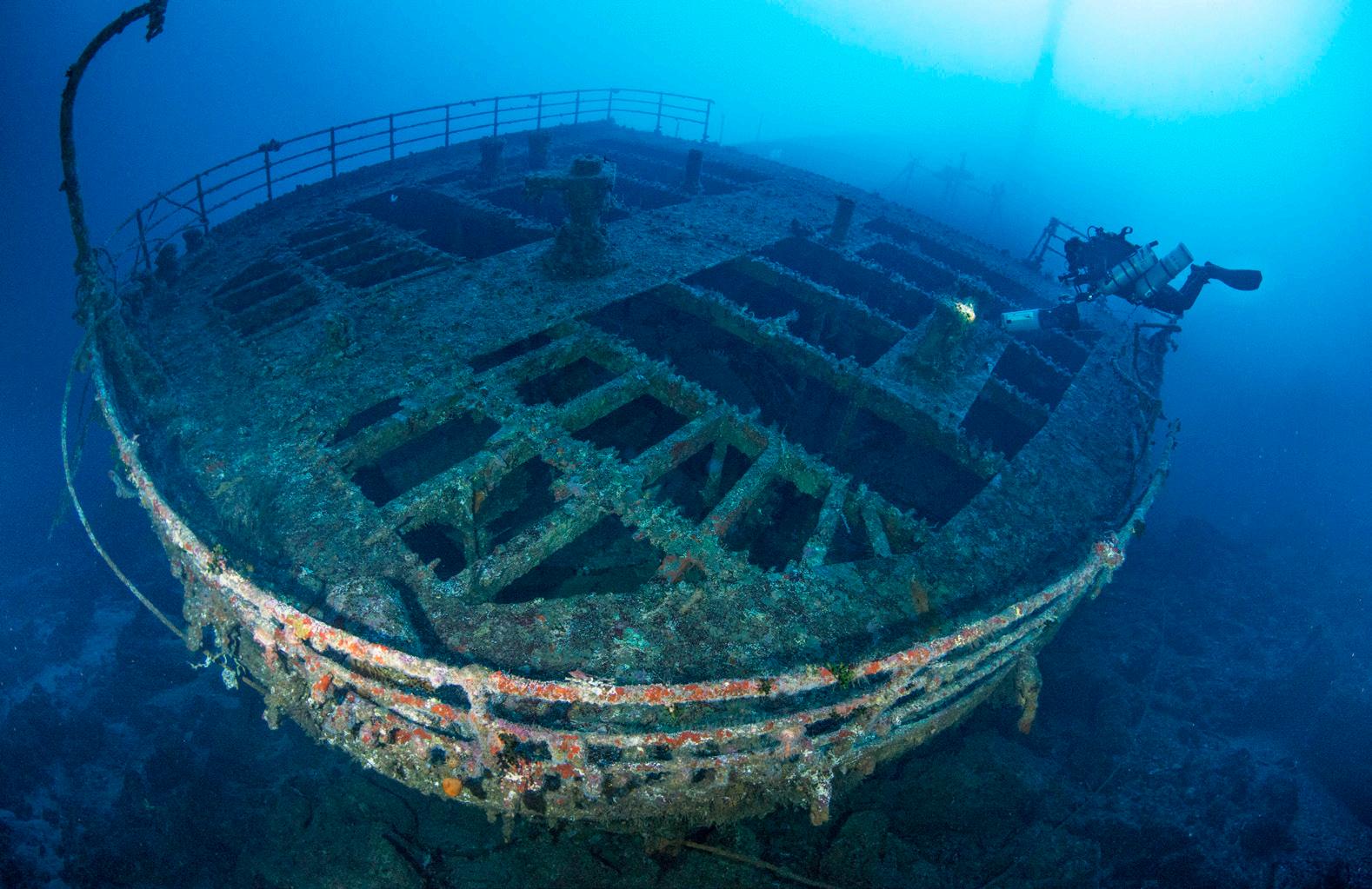
13. SS Numidia at Brothers Island, Northern Red Sea, lost in 1901.
The SS Numidia was built in Scotland and embarked on her maiden voyage in February 1901. The ship’s second journey however, would be her last.
After a smooth passage of the Suez Canal, the ship hit the Big Brother Lighthouse and the bow was seriously damaged. The captain ordered the crew into the lifeboats. He stayed on the island for seven weeks to supervise the salvage of the ship’s cargo, before the hull finally slid into the depths of the reef’s northern tip. The marine life on the Numidia, especially the soft corals, are splendid, and the setting with the impressive stern at 80 metres, with the reef in the background – is a spectacular sight.
14. SAN FRANCISCO MARU
TYPE Passenger Cargo ship
AREA 4th Fleet Anchorage, Truk Lagoon, Micronesia
DEPTH 62 metres
LOST 17 February 1944

14. The San Francisco Maru in Truk Lagoon, Micronesia, lost in 1944.
In 1944, Operation Hailstone wiped out most of the Japanese Pacific fleets and 275 aircraft in Truk Lagoon in just two days. With 60 wrecks to choose from, it is hard to single out just one, and at least five other Truk wrecks could have easily made it onto the list. But there is a reason why San Francisco Maru is one of the most famous wrecks in the lagoon. She is loaded to the brim with war materials such as the small Japanese HA-GO tanks, trucks, various types of ammunition, mines and aircraft parts. She is in good shape as she is one of the deeper wrecks.
15. USS SARATOGA
TYPE Aircraft Carrier
AREA Bikini Atoll
DEPTH 52 metres
LOST 25 July 1946
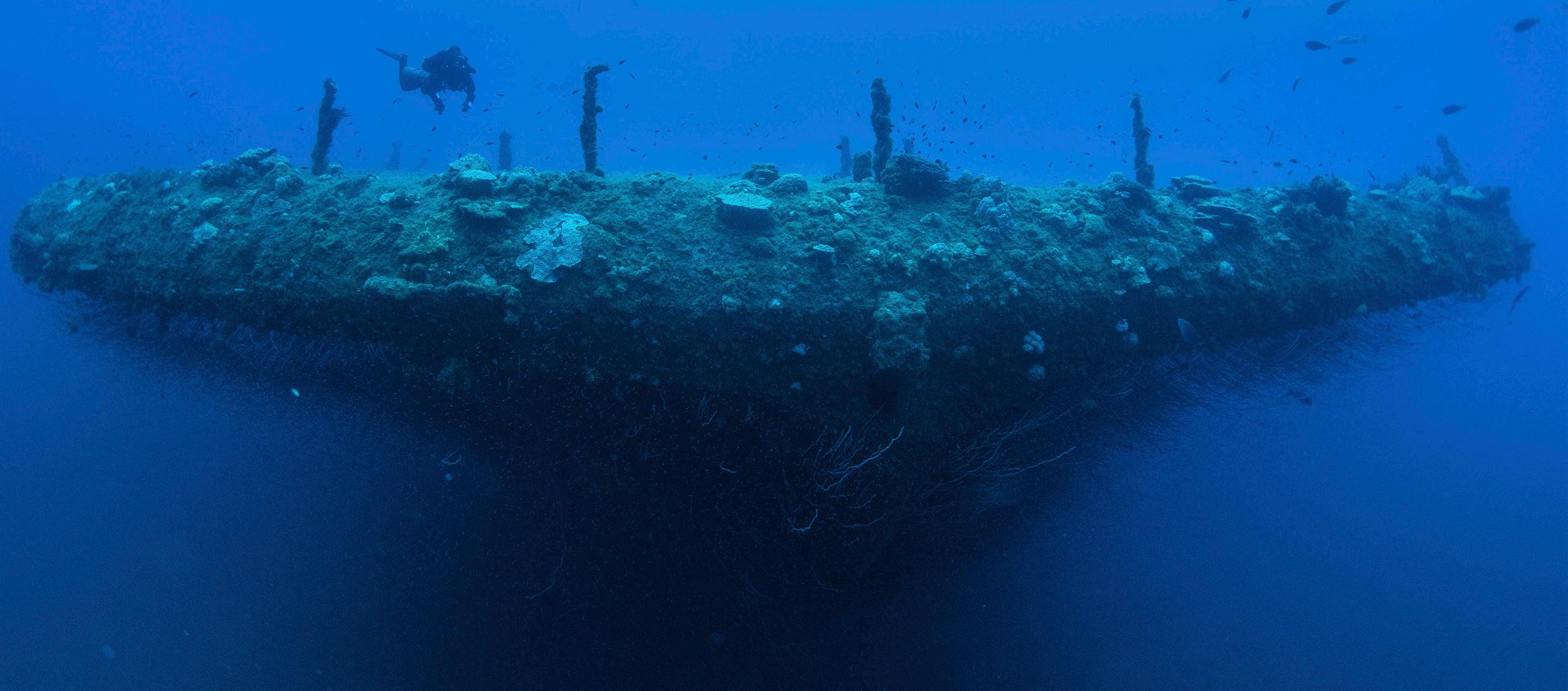
15. USS Saratoga in Bikini Atoll, lost in 1946.
In 1946, the United States conducted Operations Crossroads in Bikini to test the impact of atomic explosions on military vessels. The 270-metre-long aircraft carrier USS Saratoga had an impressive track record and was involved in many major conflicts and campaigns during WWII, but after the war she became a sitting duck in Bikini. She survived the first blast, but succumbed to the second three weeks later.
Sara is most likely the largest diveable wreck in the world and with so many penetration possibilities and an abundance of details inside and outside, you could easily go to Bikini and only dive the USS Saratoga for a week. In fact, if the aircraft carrier was the only wreck here, it would still be worth the long journey.
16. THISTLEGORM
TYPE Cargo Ship
AREA Straight of Gubal, Northern Red Sea
DEPTH 32 metres
LOST 6 October 1941

16. Thistlegorm in the Straight of Gubal, Northern Red Sea, lost 1941.
One thing is certain: no diving career is complete without this wreck in your logbook. In September 1941, she was part of a convoy up through the Red Sea. While anchored, waiting for the Suez Canal to open, her ammunition stores in hold 4 were struck by a 2.5 ton bomb from a German Heinkel He 111 and she sank immediately. Thistlegorm owes her stardom to the amazing cargo of military vehicles, motorbikes, aeroplane spare parts, weapons and ammunition. But her legacy is even more impressive as she was found and explored (looted) by Jacques Cousteau in the early 1950s. She was then lost again until an Israeli liveaboard rediscovered her in the early 1990s. Since then, the huge number of daily divers has taken its toll and parts of her have collapsed, but she is still an epic dive.
17. SS MAIDAN
TYPE Steam Cargo Ship
AREA Rocky Island, Southern Egypt
DEPTH 120 metres
LOST 9 June 1923
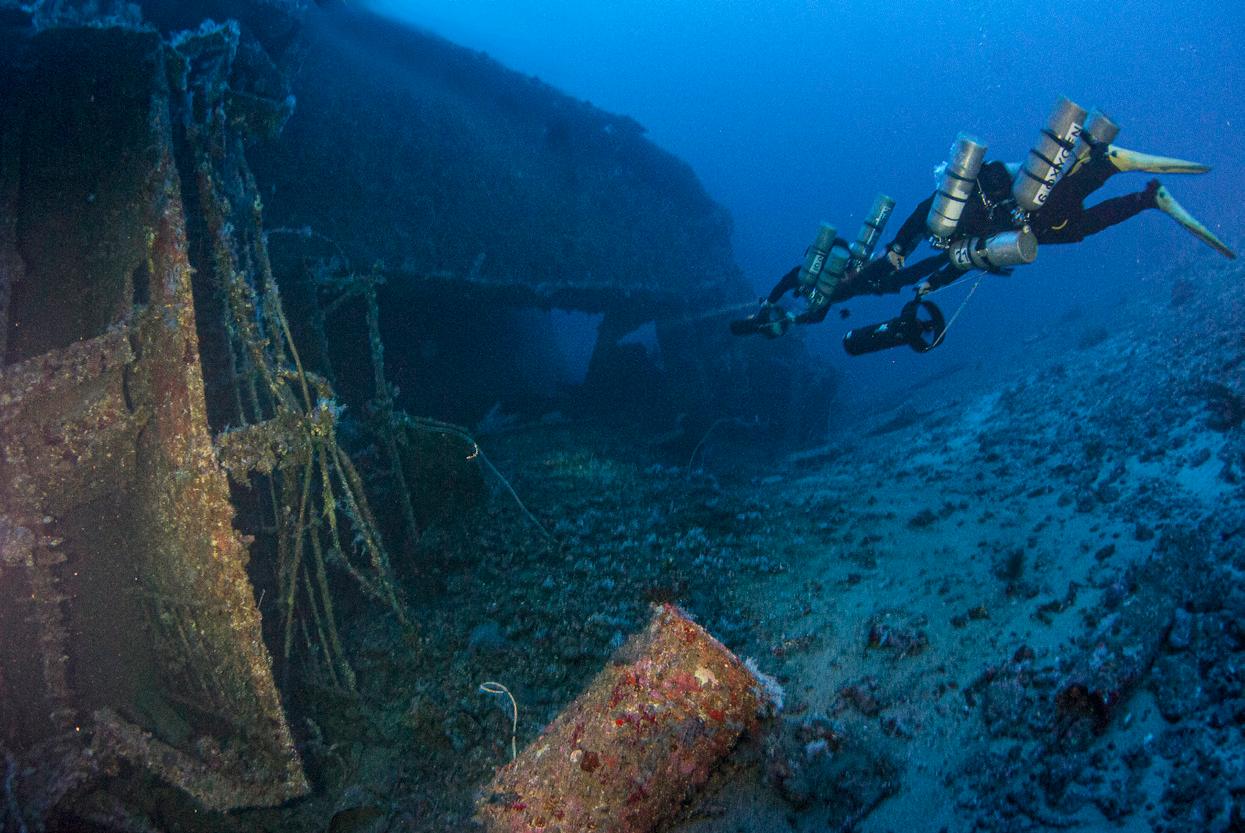
17. The SS Maidan at Rocky Island, Southern Egypt, sunk in 1923.
SS Maidan hit Rocky Island on her way back to Europe after visiting India. She disappeared in deep water with her cargo of colonial imports – including elephant tusks – but not until the crew and the passengers managed to get to the island where they were rescued that same day.
Because of the depth and the inaccessible position, not many dives have been conducted here since her discovery in 2003, so the 152-metre-long wreck is still in very good condition with some nice penetration options, including engine room and cargo holds. During decompression stops along the spectacular walls of Rocky Island, it is not uncommon to be accompanied by tiger sharks or curious longimanus.
18. UMBRIA
TYPE Cargo and Passenger Ship
AREA Wingate Reef, Port Sudan
DEPTH 35 metres
LOST 9 June 1941

18. Umbria at Wingate Reef in Port Sundan, lost in 1941.
Italy had not officially joined WWII on the German side when Umbria fully loaded with ammunition and war supplies was anchored outside Port Sudan.
The British had a suspicion and detained the Italian ship and its crew. Umbria’s captain heard Italy’s declaration of war on the radio and realised the Brits would impound the cargo, so he managed to scuttle the 155-metre-long ship under the pretence of doing a muster drill. Umbria lies on its port side with the davits still sticking out of the water. She has enough explosives in her hulls to blow Port Sudan to kingdom come.
19. SS YONGALA
TYPE Passenger Ship
AREA Great Barrier Reef South of Townsville, Queensland
DEPTH 33 metres
LOST 23 March 1903

19. SS Yongala in the Great Barrier Reef, Queensland, lost in 1903.
SS Yongala steamed into a tropical cyclone and 122 crew and passengers died in the disaster. The wreck was not located until 1958 and has since become a major tourist attraction. Due to the many fatalities, it is not allowed to penetrate the wreck, but the marine life surrounding Yongala is amazing as the structure provides an oasis in the barren underwater landscape. Majestic fan corals, soft and hard corals decorate the reef. Giant groupers, eagle rays, mantas and various sharks are spotted frequently, and the site is also visited by minke or humpback whales between June and November.
20. ZENOBIA
TYPE Roll On-Roll Off Ferry
AREA Larnaca Cyprus
DEPTH 42 metres
LOST 7 June 1980
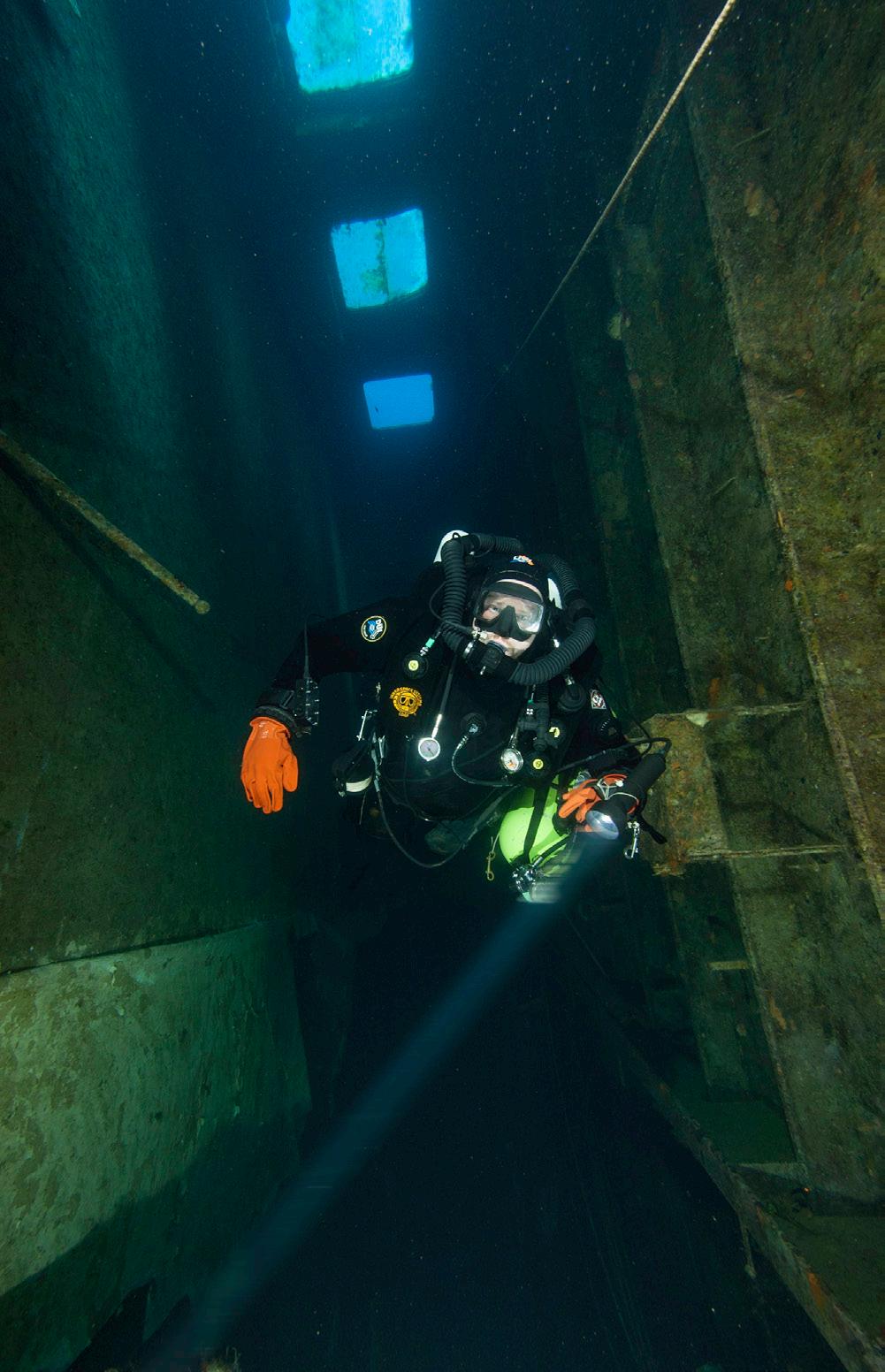
20. Zenobia in Larnaca, Cyprus, lost in 1980.
The Swedish RO-RO ferry was on her maiden voyage from Malmö, Sweden bound for Syria. During a stop in Cyprus, the ship began listing to port and it was discovered that excess water was being pumped into the ballast tanks due to a computer malfunction. She was towed out of the harbour in Larnaca to prevent her from becoming an obstruction, and a few days later the captain had to order everyone to leave the sinking ship with its cargo of trucks estimated to be worth £200 million. This enormous wreck has been hugely important to the diving industry in Cyprus. Zenobia is a giant playground for divers of all levels.










